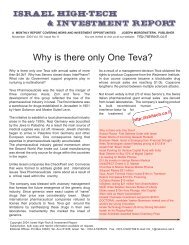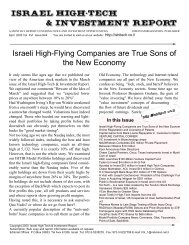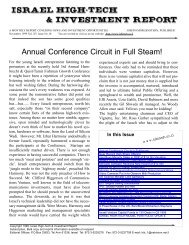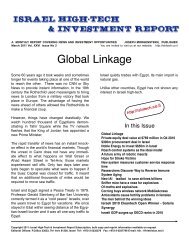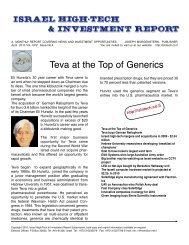Water, Water Everywhere... - The Israel High Tech & Investment Report
Water, Water Everywhere... - The Israel High Tech & Investment Report
Water, Water Everywhere... - The Israel High Tech & Investment Report
Create successful ePaper yourself
Turn your PDF publications into a flip-book with our unique Google optimized e-Paper software.
A MONTHLY REPORT COVERING NEWS AND INVESTMENT OPPORTUNITIES JOSEPH MORGENSTERN, PUBLISHER<br />
July 2011 Vol. XXV Issue No.7<br />
You are invited to visit us at our website: http://ishitech.co.il<br />
<strong>Water</strong>, <strong>Water</strong> <strong>Everywhere</strong>...<br />
Many years ago, when we came to<br />
live in this country, the Ben Gurions<br />
befriended us. We used to visit their<br />
home on what is now called Ben-Gurion<br />
Boulevard, a few minutes walking distance<br />
from our home.<br />
So it came to us as small surprise that<br />
we received a call late one Friday afternoon<br />
inviting us to come down to Sde<br />
Boker to celebrate Paula Ben-Gurion’s<br />
birthday. We later discovered that all<br />
visitors were told that it was Paula’s<br />
birthday.<br />
Sde Boker is<br />
located in the<br />
southern part<br />
of <strong>Israel</strong>, in the<br />
wilderness. We<br />
were surprised<br />
to notice at the<br />
entrance of the kibbutz a peach orchard.<br />
When I mentioned this to Mr. Ben-Gurion<br />
he harrumphed and said “but we have<br />
to bring in our potatoes from up north”.<br />
an open ditch canal, which carried water<br />
from the Sea of Galilee to the rest of the<br />
country.<br />
<strong>The</strong> greatest step forward was the devel-<br />
http://ishitech.co.il<br />
In this Issue<br />
<strong>Water</strong>, <strong>Water</strong> <strong>Everywhere</strong>...<br />
Yissum presents a virtual cane for the visually impaired<br />
<strong>Israel</strong>i dairy cows outperform cows in EU, US<br />
Computer model of cancer growth<br />
Airbus, IAI to develop early warning system for C295<br />
Mazor’s new Renaissance robotic spinal surgery system<br />
Jive Software buys OffiSync, its biggest acquisition yet<br />
<strong>Israel</strong>i arms industry a major economic engine<br />
<strong>Israel</strong>i start-up offers minty solution for bad breath<br />
DG to acquire MediaMind for $517m in cashParis Air Show features<br />
top <strong>Israel</strong>i technology<br />
Image sensor Advasense acquired by Pixim<br />
General Electric to set up new <strong>Israel</strong>i R&D center<br />
VMware buys SaaS Digital Fuel for $85m.<br />
How adversity dulls our perceptions<br />
<strong>The</strong> problem of scarcity of water is as<br />
old as the State.<br />
First efforts to alleviate the situation<br />
was the National <strong>Water</strong> Carrier. It was<br />
Copyright 2011: <strong>Israel</strong> <strong>High</strong>-<strong>Tech</strong> & <strong>Investment</strong> <strong>Report</strong> Subscription, bulk copy and reprint information available on request<br />
Editorial Offices: P.O.Box 33633, Tel- Aviv 61336, <strong>Israel</strong> Tel-: +972-3-5235279 Fax: +972-3-5227799 E-mail: htir_1@netvision.net.il
July-August<br />
opment of the <strong>Israel</strong> Desalination company.<br />
Relying on osmosis technology<br />
it build there largest desalination plant<br />
in the world. It supplies 13% of <strong>Israel</strong>’s<br />
total water consumption.<br />
Saving water was another approach.<br />
An engineer’s invention resulted in drip<br />
irrigation. This provided water directly to<br />
the roots of plants, without any waste.<br />
Netafim, the kibbutz industry that<br />
specializes in drip irrigation was sold<br />
recently for $850. million. to Private<br />
equity firm Permira.<br />
..<br />
Last year, revenues from the desalination<br />
and water related industries<br />
exceeded $2.0 billion, weith expectations<br />
fo further rapid growth.<br />
<strong>Israel</strong>’s dire need for water will undoubtedly<br />
spur the further rapid growth of<br />
the desalination industry.We recently<br />
spoke to the spokesman for the government<br />
who assured me that in three<br />
years <strong>Israel</strong> will become completely<br />
independent for water supplies.<br />
Yissum presents a virtual cane<br />
for the visually<br />
impaired<br />
Yissum Research<br />
Development Company<br />
Ltd., the technology<br />
transfer company<br />
of the Hebrew<br />
University of Jerusalem, presented at<br />
the <strong>Israel</strong>i Presidential Conference,<br />
a virtual cane that will significantly<br />
improve the orientation and mobility of<br />
sight-impaired people. This new device<br />
can assist blind people in estimating<br />
the distance and height of various<br />
obstacles. <strong>The</strong> invention was registered<br />
as a patent by Yissum, which is<br />
now seeking strategic partners for further<br />
development.<br />
Currently there are almost 200 million<br />
visually impaired people globally, 40 million<br />
of which are legally blind, and most<br />
face multiple difficulties in orientation<br />
and navigation. One of the main challenges<br />
facing blind people is the ability<br />
to assess the height of various obstacles<br />
as well as to identify far away objects in<br />
their surroundings. <strong>The</strong> white cane, the<br />
current solution, offers only a very partial<br />
solution to these challenges.<br />
Dr. Amir Amedi from the Institute for<br />
Medical Research <strong>Israel</strong>-Canada and at<br />
Edmond and Lily Safra Center for Brain<br />
Sciences at <strong>The</strong> Hebrew University of<br />
Jerusalem and his team recently developed<br />
a device to help in spatial navigation<br />
for the blind. <strong>The</strong> invention, which<br />
functions as a virtual flashlight, can<br />
replace or augment the classic white<br />
cane. <strong>The</strong> virtual cane emits a focused<br />
<strong>Israel</strong> <strong>High</strong>-<strong>Tech</strong> & <strong>Investment</strong> <strong>Report</strong><br />
Published monthly since January 1985<br />
Publisher and Editor in Chief<br />
Joseph Morgenstern, B.A. Chem.<br />
<strong>Tech</strong>nology Review Board<br />
Prof. S.J. Joel-Cohen, MD, FRCS. FRCOG (1996-2002)<br />
Prof. Hylton Miller, M.B. Ch.B.<br />
Dr. Clive L. Carpel, M.B. Ch.B.<br />
Copy Chief<br />
Debbie Mor<br />
Web Master<br />
Marty vonBokel<br />
Graphics Consultant<br />
Daniel Morgenstern<br />
Subscription Inquiries<br />
Tel-. +972-3-5235279 Fax. +972 3-5227799<br />
E-mail: htir_1@netvision.net.il<br />
Annual subscription $95.- per year, for 11 issues,<br />
<strong>Israel</strong>i residents add 17% VAT<br />
Web Edition and Achives<br />
http://ishitech.co.il<br />
2
July-August 2011<br />
beam towards surrounding objects, and<br />
transmits the information to the user via<br />
a gentle vibration, similar to a cell phone<br />
vibration. <strong>The</strong> cane incorporates several<br />
sensors that estimate the distance<br />
between the user and the object it is<br />
pointed at. This allows the blind person<br />
to assess the height and distance of<br />
various objects, reconstruct an accurate<br />
image of the surroundings and navigate<br />
safely. <strong>The</strong> virtual cane is extremely<br />
small, easy to carry, accurate, can function<br />
for up to 12 hours and is easy<br />
to charge. Using the device is highly<br />
intuitive and can be learned within a few<br />
minutes.<br />
Researchers in Dr. Amedi’s lab employ<br />
the virtual cane in various environments<br />
in order to study the brain, its flexibility<br />
and reorganization in blind people. For<br />
example, the researchers constructed<br />
a real maze that enables subjects to<br />
practice walking in changing environments<br />
and paths. To date, more than 10<br />
subjects have already successfully navigated<br />
the maze, and after a very short<br />
practice period managed to completely<br />
avoid walls and obstacles.<br />
<strong>Israel</strong>i dairy cows outperform cows<br />
in EU, US<br />
Data released by<br />
the Central Bureau<br />
of Statistics show<br />
that <strong>Israel</strong>i dairy<br />
cows produce<br />
more milk than<br />
their counterparts<br />
in other countries.<br />
<strong>The</strong> study said local cows produced an<br />
average of 10,208 kilograms (nearly<br />
2,642 gallons, around 10,000 liters) of<br />
dairy in 2009, outperforming cows in the<br />
US (9,331 kg. per cow, 2,465 gallons),<br />
Japan (7,497), the European Union<br />
(6,139 , 1,622 gallons) and Australia<br />
(5,601).<br />
A total of 1,304 million liters of milk<br />
(344,480 gallons of milk) was produced<br />
by <strong>Israel</strong>i cows in 2010, a slight increase<br />
on the previous year. A cow from Kibbutz<br />
Karmia near Gaza was named the best<br />
milk producer for the second year in a<br />
row, giving more than 20,000 liters of<br />
milk, or about 5,283 gallons, in one year.<br />
<strong>The</strong>re are some 125,000 dairy cows in<br />
<strong>Israel</strong>, and the average <strong>Israel</strong>i consumes<br />
about the equivalent of 45 gallons of<br />
dairy products a year.<br />
Computer model of cancer growth<br />
A computer model that predicts genes<br />
essential for cancer cell growth could<br />
provide an important step toward better<br />
cancer treatments, <strong>Israel</strong>i researchers<br />
say.<br />
Rapid, uncontrolled growth is the hallmark<br />
of the disease, but to maintain<br />
their abnormal growth, cancer cells must<br />
modify and shut off certain metabolic<br />
genes, an article in the journal Molecular<br />
Systems Biology reported Tuesday.<br />
Tomer Shlomi, Eytan Ruppin and colleagues<br />
have developed a computer<br />
simulation of cancer metabolism to predict<br />
which genes are essential for cancer<br />
cell growth.<br />
By understanding cancer metabolism,<br />
researchers say, they hope to identify<br />
drugs and therapies that specifically target<br />
and disrupt the growth of cancer<br />
cells.<br />
When specific metabolic genes are<br />
known to be turned off within a particular<br />
cancer, the researchers say they<br />
can predict treatments that selectively<br />
3
July-August<br />
target that cancer without disrupting the<br />
metabolism of healthy tissues, leading to<br />
the possibility of new cancer therapies<br />
with lesser side effects<br />
Airbus, IAI to develop early warning<br />
system for C295<br />
Airbus Military and <strong>Israel</strong> Aerospace<br />
Industries (IAI) will jointly develop a new<br />
version of an early warning system for<br />
the Airbus Military C295 aircraft.<br />
<strong>The</strong> two companies signed a memorandum<br />
of understanding at the recently<br />
held Paris Air Show.<br />
With this agreement, Airbus Military will<br />
expand its mission capability to the<br />
airborne early warning and command<br />
sector, while IAI’s Elta will expand its<br />
AEW&C fleet to include a turboprop<br />
platform.<br />
“We see a growing demand emerging for<br />
medium-size early warning systems and<br />
platforms at an affordable price for both<br />
air defense and homeland security,” Airbus<br />
Military CEO Domingo Urena said.<br />
<strong>The</strong> C295 is part of Airbus Military’s family<br />
of light and medium airlifters.<br />
Airbus Military, a subsidiary of Airbus,<br />
has sold more than 1,000 aircraft to<br />
military, civilian and governmental customers<br />
Mazor’s new Renaissance robotic spinal<br />
surgery system<br />
<strong>Israel</strong>i Mazor Robotics has unveiled its<br />
new Renaissance spinal robotic surgical<br />
guidance system. <strong>The</strong> device takes<br />
advantage of the same technology inside<br />
Mazor’s SpineAssist , but improves on<br />
usability through new hardware and<br />
software. <strong>The</strong> Renaissance system<br />
has already received both FDA<br />
clearance and EU’s CE Mark of<br />
approval<br />
Renaissance features an entirely<br />
new design and human interface,<br />
as well as next-generation hardware<br />
and software technologies.<br />
<strong>The</strong>se are designed to increase<br />
surgical safety as well as extend<br />
the range of clinical applications,<br />
enabling osteotomies, transfacet<br />
and translaminar-facet implant<br />
placements, in addition to procedures<br />
such as spinal fusions and<br />
scoliosis corrections currently<br />
performed with Mazor Robotics’<br />
technology. Renaissance<br />
also serves as a platform that<br />
will support future clinical applications,<br />
such as robotic-guided<br />
cranial surgeries.<br />
Continuing Mazor Robotics’ commitment<br />
to safety, Renaissance<br />
reduces radiation protocols for<br />
preoperative<br />
CTs by<br />
up to 50%,<br />
w h i c h<br />
m e a n s<br />
p a t i e n t s<br />
will be<br />
exposed to significantly less<br />
radiation. <strong>The</strong> company also<br />
collaborated with surgeons on<br />
developing surgical tools and<br />
technological enhancements for<br />
Renaissance that further reduce<br />
the potential for human error.<br />
Medical cyberbots may be crawling<br />
around inside you<br />
It may sound like something<br />
straight out of “<strong>The</strong> Matrix,” but<br />
advances in robotic miniaturization<br />
have made it a reality. It isn’t<br />
4
July-August 2011<br />
a future concept anymore.<br />
“<strong>The</strong>y’re Here!”<br />
Example: <strong>Israel</strong>i researchers from <strong>Tech</strong>nion<br />
Medical Robotics Laboratory at the<br />
<strong>Israel</strong> Institute of <strong>Tech</strong>nology created<br />
“ViRob”, with a diameter of just 1 millimeter<br />
wide, 14mm long, it was designed<br />
to crawl through vessels and cavities.<br />
It can deliver a dosage of medication<br />
to a precise location in the body, or pull<br />
a microcatheter deep inside where it<br />
would normally not have been able to<br />
reach previously.<br />
Researchers can also use ViRob to<br />
deliver drugs in lung cancer patients, as<br />
well as take tissue samples from different<br />
areas inside the body.<br />
As development progresses, it will be<br />
possible to add miniature tongs, video<br />
camera, and other extra functions as<br />
needed. ViRob is just one of many different<br />
types of medical microbots being<br />
developed.<br />
Research is under way to make nanobots<br />
even smaller, much smaller... down to a<br />
molecular level. <strong>The</strong> NANOBOT. When<br />
this happens, we will have hundreds of<br />
medical cyberbots patrolling our bodies,<br />
carrying out routine tasks such as scouring<br />
the insides of our arteries to remove<br />
plaque, all but eliminating heart attacks,<br />
atherosclerosis, and much more.<br />
Molecular bots could assemble other<br />
bots while inside the body as needed for<br />
specific tasks.<br />
A first wave of molecular bots could<br />
detect cancer cells, target them, and<br />
remove them before cancer can get<br />
started, while a second wave delivers<br />
anti-cancer medication to the exact spot<br />
where the cancer cells were just targeted<br />
and removed.<br />
While this is truly an amazing thing, a<br />
benefit to mankind, it also brings with<br />
it some very ugly and serious ethical<br />
questions...<br />
Who will be able to afford this Only<br />
wealthy individuals, or will the common<br />
peasant in a third world country be able<br />
to have it as well<br />
Some doomsayers may go so far to say<br />
thing such as: If mankind eliminates cancer<br />
and heart attacks, people start living<br />
much longer, world population increases<br />
beyond any normal conditions, famine<br />
and world starvation kick in because we<br />
can’t produce the quantity and volume of<br />
food to feed everyone.<br />
Stop the leaks<br />
<strong>Israel</strong> is pioneering innovative water<br />
technologies that will make it possible<br />
for the country to survive and thrive without<br />
rainfall<br />
A wooden staff and a little help from God<br />
were all Moses needed to draw water<br />
from a rock, but as the executive of an<br />
<strong>Israel</strong>i water company pointed out, he<br />
didn’t share the technology. In a country<br />
where water scarcity is a hard fact of<br />
life, farmers, scientists and technologists<br />
have had to rely on innovative ideas<br />
rather than miracles.<br />
Today, the global water industry is worth<br />
$500 billion (€354 billion) a year, with<br />
water technologies valued at $100 billion<br />
alone. But despite the big numbers, it’s a<br />
conservative sector dominated by utility<br />
companies that shy away from innovation.<br />
Not so in <strong>Israel</strong>, however. A world<br />
leader, the <strong>Israel</strong>i water tech sector is<br />
valued at $2 billion, a figure that the gov-<br />
5
July-August<br />
ernment wants to increase to $10 billion<br />
over the next five years.<br />
Proving that necessity really is the mother<br />
of invention, we wandered between<br />
rows of jojoba trees on a patch of land<br />
south west of the Negev desert. About<br />
95 per cent of <strong>Israel</strong> is classed as arid<br />
or semi-arid, but companies such as<br />
Netafim are clawing back the land and<br />
making it fit for agriculture. Its drip irrigation<br />
techniques increase crop yields by<br />
50 per cent while using 40 per cent less<br />
water than alternative methods.<br />
Igal Aisenberg, chief executive of Netafim,<br />
pointed to a hole in the earth and a small<br />
underground pipe that runs the length of<br />
the field. This is the company’s product<br />
at work. Intermittently spaced drippers<br />
release water into the ground beneath<br />
the trees, a patented piece of technology<br />
that made the company a global<br />
success story and drip irrigation viable.<br />
While it remains more expensive than<br />
sprinklers and flood irrigation, drip technology<br />
is a lot more efficient, releasing<br />
water with pinpoint accuracy, an important<br />
consideration with such a scarce<br />
commodity. “It’s not just a hole in a pipe,”<br />
says Aisenberg. “It is pressure compensated<br />
so every dripper gives out exactly<br />
the same amount of water regardless of<br />
location.”<br />
Just south of Tel Aviv we see the source<br />
of the water and more cutting-edge technology.<br />
Vast man-made basins dominate<br />
the landscape, part of an industrial<br />
recharge-recovery system that reclaims<br />
waste water for use in irrigation. Run by<br />
Mekorot, <strong>Israel</strong>’s national water company,<br />
the Shafdan plant is the most<br />
advanced in the Middle East – 75 per<br />
cent of household wastewater is recycled<br />
in <strong>Israel</strong> and reused for irrigation.<br />
According to Amiad, another <strong>Israel</strong>i firm<br />
and one of the world’s leading waterfiltration<br />
companies, the only obstacle<br />
to drinking recycled wastewater is psychological.<br />
Filtration techniques have<br />
become so sophisticated that quality is<br />
not an issue.<br />
People are already drinking seawater.<br />
On the Mediterranean coast, <strong>Israel</strong> has<br />
the two largest reverse osmosis desalination<br />
plants in the world, run by a joint<br />
venture between indigenous firm IDE<br />
<strong>Tech</strong>nologies and French company Veolia<br />
<strong>Water</strong>.<br />
Pressurized seawater is pumped through<br />
thousands of polymer membranes that<br />
extract the brine and discharge it back to<br />
the ocean. Two cubic meters of seawater<br />
make one cubic meter of drinking water<br />
in industrial facilities that already supply<br />
50 per cent of the country’s household<br />
water, a figure that will increase to 70<br />
per cent with the completion of a third<br />
plant.<br />
Part of <strong>Israel</strong>’s agenda is to export its<br />
expertise and even wet countries such<br />
as Ireland are in its cross hairs. “You<br />
had a drought last winter because you<br />
couldn’t find the leaks in your infrastructure,”<br />
says Benjamin Levy, director of<br />
marketing at Miltel, a company that specializes<br />
in automatic metering and water<br />
management systems.<br />
He said 17,000 liters of water can be lost<br />
in month through a 3mm leak. Again,<br />
<strong>Israel</strong> is leading the world in tackling<br />
the problem. Only 12 per cent of water<br />
leaks out in the country’s infrastructure<br />
compared to 25 per cent in Europe, and<br />
35 per cent to 40 per cent in underdeveloped<br />
countries.<br />
6
July-August 2011<br />
Miltel has a partnership with IBM, highlighting<br />
how water tech is becoming a<br />
credible sector in the wider world. Its<br />
monitoring systems are integrated with<br />
IBM middleware to deliver smart water<br />
management and metering solutions.<br />
Miltel claims that houses with automatic<br />
reading systems encourage people to<br />
use water carefully and lead to a 15 per<br />
cent drop in consumption.<br />
Whitewater Security is another export<br />
success, selling sensors and systems<br />
for tracing water contaminants to more<br />
than 30 countries. Sales manager Rani<br />
Weinberg plays down the terrorist threat<br />
as a principal reason for deploying its<br />
technology but admits that interest in<br />
its products spiked in the United States<br />
after 9/11. Whatever the drivers, the<br />
company’s technology solves a problem.<br />
“Traditionally, laboratories are used<br />
to test water and it can take 24 to 48<br />
hours to get the results,” said Weinberg.<br />
“With our sensors in the pipes, it’s a matter<br />
of minutes.”<br />
Booky Oren, a former chairman of Mekorot,<br />
spells out the sum total of all this<br />
innovation.<br />
“By 2015, the target for <strong>Israel</strong> is to be<br />
independent of natural water resources.<br />
We won’t care if it rains or not,” he said.<br />
As chairman of Watec, an international<br />
water technology exhibition that shows<br />
off indigenous expertise to the world, he<br />
was quick to point out that water scarcity<br />
is not just <strong>Israel</strong>’s problem. <strong>The</strong>re<br />
will be a 50 per cent increase in global<br />
water demand in the next 20 years,<br />
and he is concerned that an inherently<br />
conservative industry will struggle to<br />
keep up. “Countries can’t rely on natural<br />
resources; they need to implement new<br />
technology,” he warns.<br />
Jive Software buys OffiSync, its biggest<br />
acquisition yet<br />
Jive Software announced its third acquisition<br />
in 18 months Monday -- and its<br />
biggest to date -- buying an interactive<br />
technology company called OffiSync<br />
Corp.<br />
It’s the latest social media deal in technology’s<br />
hottest sector.<br />
OffiSync integrates Microsoft products<br />
-- including Office, Outlook and Share-<br />
Point -- with other online tools, including<br />
Jive’s business collaboration software.<br />
Formally headquartered in Seattle, most<br />
of OffiSync’s employees are in <strong>Israel</strong>.<br />
It’s already got a robust presence in the<br />
Google Apps store, where users connect<br />
their Gmail account and Google Docs<br />
files with their Microsoft equivalents.<br />
Jive is a California-based company that<br />
moved its headquarters from downtown<br />
Portland to Palo Alto last year. About<br />
170 of Jive’s 370 employees still work in<br />
Oregon, including some members of its<br />
executive team.<br />
“We think it’s a way to reach a whole set<br />
of people who haven’t had the chance<br />
to get social on their desktop,” LeBlanc<br />
said.<br />
OffiSync’s tools enable Jive’s customers<br />
to move Outlook e-mails into a discussion<br />
inside Jive’s software, for example,<br />
or to collaboratively edit a Microsoft<br />
Word document.<br />
<strong>Israel</strong>i media reported OffiSync’s sale<br />
price was around $30 million. LeBlanc<br />
declined to comment on those reports,<br />
but confirmed that this is Jive’s largest<br />
purchase.<br />
7
July-August<br />
Social media is this moment’s It <strong>Tech</strong>nology.<br />
Last week, online resume hub LinkedIn<br />
turned heads across Wall Street with<br />
an unexpectedly lucrative initial public<br />
offering. Its share price doubled within<br />
hours of its IPO, fanning enthusiasm for<br />
social networking just as an economic<br />
revival loosens corporate and investor<br />
purse strings.<br />
Jive hopes to make its software a portal<br />
for all manner of intra-business communication,<br />
using tools similar to Facebook<br />
and Twitter to keep employees current<br />
and help them work together.<br />
Jive will retain OffiSync’s dozen employees,<br />
most of who work in Tel Aviv. But<br />
LeBlanc said OffiSync chief executive<br />
Oudi Antebi lives in Seattle, and will now<br />
work primarily out of Jive’s Palo Alto<br />
office. Antebi spent eight years at Microsoft,<br />
where he worked in its Office and<br />
SharePoint divisions.<br />
Jive is among the best-funded startups<br />
to emerge from Portland in many<br />
years. It’s raised $57 million in venture<br />
capital from top-shelf Silicon Valley firms<br />
Sequoia Capital and Kleiner Perkins<br />
Caufield & Byers.<br />
Jive has been using that capital to expand<br />
its technology. It bought a Colorado<br />
social media monitoring company called<br />
Filterbox early last year, and acquired a<br />
California data analysis startup called<br />
Proximal Labs last month.<br />
Although OffiSync has an established<br />
customer base, LeBlanc said Jive was<br />
primarily interested in hiring OffiSync’s<br />
engineering team and integrating Microsoft’s<br />
pervasive software into Jive’s<br />
social products.<br />
“It’s a shift from personal productivity to<br />
group collaboration,” he said.<br />
<strong>Israel</strong>i arms industry a major economic<br />
engine<br />
<strong>Israel</strong>i defense sales in 2010 totaled 7.2<br />
billion U.S. dollars, making the small<br />
nation the world’s fourth largest defense<br />
exporter.<br />
Defense officials released the figure in<br />
an official report at the Paris Air Show. A<br />
bevy of <strong>Israel</strong>i firms hope to garner even<br />
more sales at the show, after a string of<br />
recent successes.<br />
Most of the sales are from four leading<br />
companies: Elbit Systems, <strong>Israel</strong>i Aerospace<br />
Industries (IAI), Rafael, and <strong>Israel</strong><br />
Military Industries, a Defense Ministry<br />
statement said.<br />
Strong points of <strong>Israel</strong>’s<br />
arms industry<br />
include unmanned<br />
aerial vehicles,<br />
armored vehicles,<br />
smart munitions, military<br />
and civilian aircraft avionics, weapons<br />
platforms and structural upgrades<br />
for foreign governments and private<br />
clients.<br />
<strong>The</strong> Iron Dome anti-missile system,<br />
developed by Rafael, is expected to be<br />
one of the highlights of the <strong>Israel</strong>i pavilion.<br />
<strong>The</strong> system, which was deployed in<br />
southern <strong>Israel</strong> earlier this year, immediately<br />
proved its mettle on its first try, successfully<br />
intercepting several salvos of<br />
rockets fired by Palestinian militants in<br />
Gaza at <strong>Israel</strong>i towns and communities.<br />
Local analysts, however, said that the<br />
true value of the defense export isn’t<br />
the sector’s direct contribution to <strong>Israel</strong>’s<br />
8
July-August 2011<br />
economy. <strong>The</strong> main benefit is the role<br />
defense contractor’s play in developing<br />
technology and producing skilled personnel<br />
that will join the country’s high<br />
tech industry after finishing their military<br />
services.<br />
FOUR FACTORS<br />
Maj.-Gen. (retired) Giora Eiland of the<br />
<strong>Israel</strong> Defense Forces ( IDF) told Xinhua<br />
that the defense industry is essential<br />
to <strong>Israel</strong> not only because of the huge<br />
export revenue, but also for its contribution<br />
to the Jewish state’s armed forces.<br />
Eiland listed four underlying reasons for<br />
<strong>Israel</strong>i defense industry’s success.<br />
“It begins with the importance of domestic<br />
development and production,” he<br />
said.<br />
Eiland added that since the need to<br />
develop advanced weapons is essential<br />
to <strong>Israel</strong>, “at the end of the day we can<br />
use and sell it to others.”<br />
“<strong>The</strong> second reason is that <strong>Israel</strong> manages<br />
to create a clear distinctions<br />
between a political and defense relationship<br />
regarding many countries,” Eiland<br />
said. “<strong>The</strong>re are many countries that are<br />
quite hostile to us in many international<br />
forums but they do appreciate the quantity<br />
of our products.”<br />
For instance, while <strong>Israel</strong>i-Turkish political<br />
relationship began to deteriorate in<br />
the last few years, Ankara still bought 10<br />
<strong>Israel</strong>i UAVs (Unmanned aerial vehicle)<br />
in 2010.<br />
Eiland argued that <strong>Israel</strong> has found the<br />
right combination of government and<br />
private cooperation, so that the country<br />
can enjoy all the benefits of government<br />
support and guarantees to the industry,<br />
but at the same time leave enough room<br />
for private creativity and incentives.<br />
He also pointed out the very strong<br />
relationship between the armed forces<br />
and the defense industry, along with the<br />
fact that a large number of retired <strong>Israel</strong>i<br />
army officers seek employment in the<br />
defense industry. This revolving door<br />
leads to a lot of combat experience and<br />
knowledge being directly transferred into<br />
industrial fields.<br />
This cross-fertilization leads to close<br />
cooperation, so that new lessons from<br />
the field can quickly be incorporated into<br />
the development of new defense systems,<br />
Eiland said.<br />
Dr. Yaacov Lifshitz of Bar-Ilan University<br />
said that on a macro level, the defense<br />
industry isn’t a key part of the <strong>Israel</strong>i<br />
economy. However, the ripple effect of<br />
the technologies and personnel that<br />
starts out in the arms industry before<br />
moving on to civilian companies is very<br />
important.<br />
“From the point of the national economy<br />
it’s not so important - it only accounts<br />
for three percent of <strong>Israel</strong>’s GDP. But it<br />
is important as a source of technologies<br />
that are later implemented in the civilian<br />
high-tech industry,” Lifshitz said.<br />
“<strong>Israel</strong> is good because of the close<br />
relations between the end- user and<br />
the developers and producers, which<br />
is absent in some other countries. This<br />
close relationship makes for a relative<br />
short development process,” Lifshitz<br />
added.<br />
He pointed out that over the years, a lot<br />
of experience has been accumulated<br />
in the defense industry, which in some<br />
9
July-August<br />
cases was set up even before <strong>Israel</strong> was<br />
established in 1948.<br />
In addition to this experience, Lifshitz<br />
argued, <strong>Israel</strong> has a relatively high supply<br />
of qualified manpower compared<br />
to its size, which may start out in the<br />
defense industry before moving on the<br />
high tech sector.<br />
<strong>Israel</strong>i start-up offers minty solution<br />
for bad breath<br />
A Jerusalem-based start-up says they<br />
have developed a mint candy that may<br />
be a breath of fresh air to millions of<br />
people around the world suffering from<br />
halitosis, more commonly known as bad<br />
breath.<br />
“It showed around 60 percent success<br />
in all the individuals tested,” Breezy<br />
chief executive officer Hillel Lerman told<br />
Xinhua on Sunday, “and it is guaranteed<br />
to last for hours, unlike mouthwash and<br />
similar products.”<br />
<strong>The</strong> lollipop-shaped candy scrapes the<br />
bacteria that causes bad breath off the<br />
tongue. It was tested on 75 individuals,<br />
who showed no signs of halitosis up to<br />
fours hours later.<br />
<strong>The</strong> candy, named Like, is sugarless<br />
and works using micro- capsules that<br />
scrub the bacteria off and release active<br />
agents that eliminate the remaining bacteria.<br />
“It’s shaped like a lollipop,” Lerman said,<br />
“and scrapes the tongue to release zinc.<br />
You don’t even have to walk around<br />
sucking it, just use it for half a minute<br />
and you’ll have fresh breath for hours.”<br />
Bad breath is only the beginning of<br />
Breezy’s oral hygiene quest.<br />
<strong>The</strong> firm is also developing a line of<br />
products to ward off oral bacteria, including<br />
stopping smoker’s breath, mouth<br />
sores, and oral fungus.<br />
“We are working on a product to prevent<br />
cavities, that also releases an antibacterial<br />
in the mouth,” Lerman said, “and that<br />
may see the light in a few months.”<br />
Breezy officials said they would begin<br />
commercializing Like candy in Europe<br />
and the United States in coming weeks.<br />
DG to acquire MediaMind for $517m<br />
in cash<br />
<strong>The</strong> <strong>Israel</strong>i digital advertising company<br />
raised $57 million in an IPO on Nasdaq<br />
last August at a valuation of $206 million.<br />
Digital advertising company MediaMind<br />
<strong>Tech</strong>nologies Inc. (Nasdaq: MDMD) will<br />
be acquired by digital media services<br />
DG FastChannel Inc. (Nasdaq: DGIT)<br />
for $517 million in cash.<br />
DG said that the acquisition creates<br />
one of the premier global online and<br />
television advertising<br />
technology<br />
companies. <strong>The</strong><br />
boards of directors<br />
of both companies<br />
have approved the acquisition.<br />
DG will commence a tender offer to<br />
purchase all of MediaMind’s outstanding<br />
shares for $22 per share in cash, at an<br />
equity value of $517 million, including<br />
the company’s $100 million in cash. <strong>The</strong><br />
share price closed at $15.94 yesterday,<br />
giving a market cap of $303 million.<br />
<strong>The</strong> company’s largest shareholder is<br />
the Sycamore Fund owned by Eli Bar-<br />
10
July-August 2011<br />
kat, brother of Jerusalem Mayor Eli<br />
Barkat, which has a 20% stake in Media-<br />
Mind and will receive $82 million. Insight<br />
Ventures holds a 16.5% stake and will<br />
receive $68 million. Former Koor CEO<br />
Jonathan Kolver holds a 5.7% stake and<br />
will receive $24 million. MediaMind held<br />
its IPO on Wall Street less than a year<br />
ago when it raised $57 million at a company<br />
value of $206 million.<br />
After the acquisition is completed, MediaMind<br />
president and CEO Gal Trifon<br />
will become DG chief digital officer, and<br />
MediaMind chief solutions officer Ofer<br />
Zadikario will assume the same position<br />
at DG.<br />
Trifon said, “We believe this transaction<br />
is the next step for MediaMind. DG will<br />
provide us with the added scale and<br />
resources to continue to grow our platform<br />
and enhance the services we provide<br />
our customers. Working together<br />
with DG, we will provide a single solution<br />
for advertising creation, distribution,<br />
and monitoring for cross-platform campaigns.<br />
We are excited to partner with<br />
DG to continue to increase our base of<br />
large advertisers and expand our global<br />
operations, and we are confident that<br />
our employees will benefit from the<br />
greater opportunities at the combined<br />
company.”<br />
DG president and COO Neil Nguyen<br />
said, “With this acquisition, we will build<br />
on MediaMind’s global operational footprint<br />
and world class technology platform<br />
to expand our reach beyond North<br />
America. <strong>The</strong> combined companies will<br />
serve a global customer base and enable<br />
DG to penetrate such markets as Latin<br />
America, Asia and EMEA.”<br />
<strong>The</strong> two companies had over $100 million<br />
in digital advertising revenue on a<br />
pro forma basis in the year through the<br />
first quarter of 2011.<br />
MediaMind operates in the fast-growing<br />
$71 billion global online advertising market.<br />
Headquartered in New York, Media-<br />
Mind has 37 sales and representation<br />
offices covering 64 countries. In 2010,<br />
the company delivered campaigns for<br />
9,000 brand owners using 3,800 media<br />
and creative agencies across 8,200<br />
global web publishers in 64 countries.<br />
Paris Air Show features top <strong>Israel</strong>i<br />
technology<br />
La Bourget – the Paris Air Show, is one<br />
of the most important showcases for military,<br />
defense, and aviation products and<br />
developments. This year marks the 49th<br />
anniversary of the show, and <strong>Israel</strong> will,<br />
once again, put on display some of the<br />
groundbreaking defensive and weapons<br />
systems developed here.<br />
Two of the most exciting products coming<br />
out of <strong>Israel</strong> this year – and, observers<br />
said, two of the most exciting products<br />
to be on display at the show altogether<br />
– are the Iron Dome short-range rocket<br />
defense system, and the Trophy “Windjacket”<br />
active protection system for light<br />
and heavy armored fighting vehicles.<br />
<strong>The</strong> Iron Dome system, already being<br />
successfully deployed in southern <strong>Israel</strong>,<br />
was developed by Rafael Advanced<br />
Defense Systems, and was designed to<br />
intercept short-range missiles fired by<br />
Hamas terrorists at <strong>Israel</strong>i towns and villages.<br />
<strong>The</strong> version to be unveiled at the<br />
Paris show can be mounted on trucks,<br />
allowing it to redeploy at different positions<br />
quickly. <strong>The</strong> Trophy system intercepts<br />
and destroys missiles and rockets<br />
fired at tanks and armored vehicles with<br />
a shotgun-like blast. This system, too<br />
11
was developed by Rafael, in coordination<br />
with IAI’s Elta Group, and was successfully<br />
deployed for the IDF earlier<br />
this year.<br />
Other products and technologies on display<br />
will include <strong>Israel</strong> Aircraft Industry’s<br />
MLGB (Medium-weight Laser Guided<br />
Bomb), an advanced laser/GPS-guided<br />
long-range projectile with a 115 kg warhead,<br />
said to be highly accurate and<br />
providing rapid point-and-shoot capabilities<br />
from fighter jets and light planes. IAI<br />
will also be showing its AD-STAR (Air<br />
Defense and Air Traffic Control Radar)<br />
3D portable radar system used for air<br />
defense, early warning, and air trafficcontrol<br />
purposes.<br />
Also on display will be the latest developments<br />
for Rafael’s popular Spike Anti-<br />
Tank Guided Missile series, in use by 20<br />
countries around the world and considered<br />
among the most accurate missiles<br />
in the world, as well as new versions of<br />
the SPYDER anti-aircraft missile system.<br />
Representing Rafael at the show will be<br />
Rafael Board Chairman Ilan Biran, and<br />
CEO Yediya Ya’ari.<br />
Image sensor Advasense acquired by<br />
Pixim<br />
Advasense raised $31 million in 2005-<br />
0 7 , but has reportedly been<br />
s o l d for only a few million dollars.<br />
Pixim Inc. of the US has acquired Advasense<br />
<strong>Tech</strong>nologies Ltd., a developer<br />
of next-generation CMOS image sensor<br />
technology. <strong>The</strong> companies did not<br />
disclose the value of the deal, which<br />
July-August<br />
was mostly in shares, warrants, and the<br />
assumption of Advasense’s debt, but it<br />
was reportedly for a few million dollars.<br />
Advasense was founded in 2005, and a<br />
review of the company’s founders and<br />
management indicates its potential. <strong>The</strong><br />
company chairman is backed by Gideon<br />
Barak, one of <strong>Israel</strong>’s top high-tech entrepreneurs,<br />
whose achievements was the<br />
sale of DSP Communications to Intel<br />
Corporation (Nasdaq: INTC) for $1.6 billion,<br />
and by Vladimir Koifman, a former<br />
executive at Applied Micro Circuits Corporation<br />
(Nasdaq: AMCC). Advasense<br />
CEO Naftaly Sharir was formerly CEO<br />
of Emblaze Research Ltd., which was<br />
sold to Zoran Corp. (Nasdaq: ZRAN),<br />
and of Electronics Line 3000 Ltd. (EL3K)<br />
(FSE:ELN).<br />
According to <strong>Israel</strong> Venture Capital (IVC),<br />
Ra’anana-based Advasense raised $31<br />
million in 2005-07 from Giza Venture<br />
Capital, BlueRun Ventures. Venture<strong>Tech</strong><br />
Alliance, and Taiwan’s CIDC.<br />
General Electric to set up new <strong>Israel</strong>i<br />
R&D center<br />
<strong>The</strong> Haifa R&D center<br />
will do basic research in<br />
medical devices, clean<br />
energy, and water technologies.<br />
General Electric (NYSE:<br />
GE), one of the world’s largest companies,<br />
will open its a multidisciplinary R&D<br />
center in <strong>Israel</strong>, its eighth R&D center in<br />
the country, at an investment of $3-5<br />
million. <strong>The</strong> R&D center will engage in<br />
research in medical devices, water, and<br />
clean energy.<br />
<strong>The</strong><br />
<strong>Israel</strong> <strong>High</strong>-<strong>Tech</strong> & <strong>Investment</strong> <strong>Report</strong> is a monthly report dealing with news, developments and investment opportunities in the universe of <strong>Israel</strong>i technology<br />
and business. While effort is made to ensure the contents’ accuracy, it is not guaranteed. <strong>Report</strong>s about public companies are not intended as<br />
promotion of shares, nor should they be construed as such.<br />
12
<strong>The</strong> R&D center will be set up in Haifa,<br />
near the center of GE subsidiary GE<br />
Healthcare, which has hundreds of<br />
employees who work on medical imaging<br />
systems.<br />
GE currently has 450 employees at<br />
seven centers in <strong>Israel</strong>, out of the company’s<br />
total global workforce of 30,000.<br />
GE has a market cap of $194 billion. <strong>The</strong><br />
other <strong>Israel</strong>i centers focus on specific<br />
products, while the new R&D center in<br />
Haifa will conduct more basic and general<br />
research.<br />
GE will hire 12 researchers when the<br />
new R&D center is opened. Oded Meirav,<br />
who has been VP business development<br />
at GE Global Research Center for<br />
the past four years, will head it. He was<br />
responsible for establishing GE’s collaborations<br />
with <strong>Israel</strong>i companies, such<br />
as medical devices companies InSightec<br />
Image Guided Treatment Ltd., WideMed<br />
Ltd. (TASE:WDMD), DeepBreeze Ltd.,<br />
and Arineta Ltd.; with Shai Agassi’s<br />
electric car venture Better Place LLC;<br />
and with cleantech companies Desalitech<br />
Ltd., Emefcy Ltd., Solaredge Ltd.,<br />
GridON Ltd., and Winflex Ltd.; and with<br />
water companies incubator Kinrot <strong>Tech</strong>nology<br />
Ventures.<br />
One of GE’s goals in setting up the new<br />
center is to establish partnerships with<br />
<strong>Israel</strong>i high-tech companies and academe.<br />
“<strong>Israel</strong> has a rich history of innovation<br />
and scientific discovery, says GE<br />
Global Research VP advanced technologies<br />
Michael Idelchik. “With the establishment<br />
of the new R&D center, we will<br />
be in a better position to build a close<br />
relationship with the <strong>Israel</strong>i technology<br />
community and identify new technologies<br />
that could become part of our portfolio.”<br />
13<br />
July-August 2011<br />
<strong>The</strong> research team will focus on renewable<br />
energy, energy storage, smart grid,<br />
and energy efficiency technologies. It<br />
will also work on water monitoring, purification,<br />
wastewater treatment, brackish<br />
water and seawater desalination technology;<br />
and in healthcare, on non-invasive<br />
medical devices, advanced diagnostic<br />
tools, and medical navigation and guidance<br />
systems.<br />
<strong>The</strong> R&D center’s researchers will collaborate<br />
with GE Capital’s life sciences<br />
and energy funds, which invest in innovative<br />
technologies.<br />
VMware buys SaaS Digital Fuel for<br />
$85m.<br />
VMware has announced its second<br />
<strong>Israel</strong>i acquisition.<br />
VMware Inc. (NYSE: VMW) has<br />
announced that it has acquired <strong>Israel</strong>i<br />
SaaS company Digital Fuel Ltd.. No<br />
price for the acquisition was disclosed<br />
but it is believed to be for about $85 million.<br />
Digital Fuel is a veteran developer of<br />
SaaS IT financial management solutions.<br />
CEO <strong>Israel</strong> Dancziger, CTO Gilad<br />
Raz, VP engineering Yakov Kogan, and<br />
Benny Lehman who died in 2004, founded<br />
the company in 2000. <strong>The</strong> company<br />
has a large number of investors, including<br />
Benchmark Capital, <strong>Israel</strong> Seed<br />
Partners, Apax Partners, Sigma Capital,<br />
and Check Point Software <strong>Tech</strong>nologies<br />
Ltd. (Nasdaq: CHKP) founder Shlomo<br />
Kramer. $45 million has been invested<br />
in Digital Fuel to date.<br />
<strong>The</strong> acquisition will be VMware’s second<br />
in <strong>Israel</strong>, having bought B-Hive Ltd.<br />
three years ago for $60 million and built<br />
operations of its <strong>Israel</strong> development cen-
July-August<br />
ter in Herzliyah Pituach around it.<br />
<strong>The</strong> acquisition of Digital Fuel will add<br />
150 employees to VMware’s workforce,<br />
a third of them at Digital Fuel’s <strong>Israel</strong>i<br />
development center. <strong>The</strong> acquisition<br />
could therefore increase the workforce<br />
at VMware’s <strong>Israel</strong>i development center<br />
by over 50%.<br />
How adversity dulls our perceptions<br />
Adversity, we are told, heightens our<br />
senses, imprinting sights and sounds<br />
precisely in our memories. But new<br />
Weitzman Institute research, which<br />
appeared in Nature Neuroscience, suggests<br />
the exact opposite may be the<br />
case. Perceptions learned in an aversive<br />
context are not as sharp as those<br />
learned in other circumstances. <strong>The</strong><br />
findings, which hint that this tendency<br />
is rooted in our species’ evolution, may<br />
help to explain how post-traumatic stress<br />
syndrome and other anxiety disorders<br />
develop in some people.<br />
To investigate learning in unfavorable<br />
situations, Dr. Rony Paz of the Institute’s<br />
Neurobiology Department, together with<br />
his student Jennifer Resnik , had volunteers<br />
learn that some tones lead to<br />
an offensive outcome (e.g. a very bad<br />
odor), whereas other tones are followed<br />
by pleasant a outcome, or else by nothing.<br />
<strong>The</strong> volunteers were later tested for<br />
their perceptual thresholds – that is, how<br />
well they were able to distinguish either<br />
the “bad” or “good” tones from other<br />
similar tones.<br />
As expected from previous studies, in<br />
the neutral or positive conditions, the<br />
volunteers became better with practice<br />
at discriminating between tones.<br />
But surprisingly, when they found themselves<br />
exposed to a negative, possibly<br />
disturbing stimulus, their performance<br />
worsened.<br />
<strong>The</strong> differences in learning were really<br />
very basic differences in perception.<br />
After learning that a stimulus is associated<br />
with highly unpleasant experience,<br />
the subjects could not distinguish it from<br />
other similar stimuli, even though they<br />
could do so beforehand, or in normal<br />
conditions. In other words, no matter<br />
how well they normally learned new<br />
things, the subjects receiving the “aversive<br />
reinforcement” experienced the two<br />
tones as the same.<br />
Paz: “This likely made sense in our<br />
evolutionary past: If you’ve previously<br />
heard the sound of a lion attacking, your<br />
survival might depend on a similar noise<br />
sounding the same to you – and pushing<br />
the same emotional buttons. Your<br />
instincts, then, will tell you to run, rather<br />
than to consider whether that sound<br />
was indeed identical to the growl of the<br />
lion from the other day.”<br />
Paz believes that this tendency might<br />
be stronger in people suffering from<br />
post-traumatic stress syndrome. As an<br />
example, he points to the 9-11 terror<br />
attacks in New York. Many of those<br />
who witnessed the strikes on the towers<br />
developed post-traumatic stress syndrome,<br />
which, for many of them, can be<br />
triggered by tall buildings. Intellectually,<br />
they may know the building before them<br />
bears little similarity to the destroyed<br />
towers, but on a more fundamental,<br />
instinctive level, they might perceive all<br />
tall buildings to be the same and thus<br />
associate them with terrifying destruction.<br />
<strong>The</strong> scientific team is now investigating<br />
this idea in continuing research, in<br />
which they hope, among other things,<br />
to identify the<br />
14





